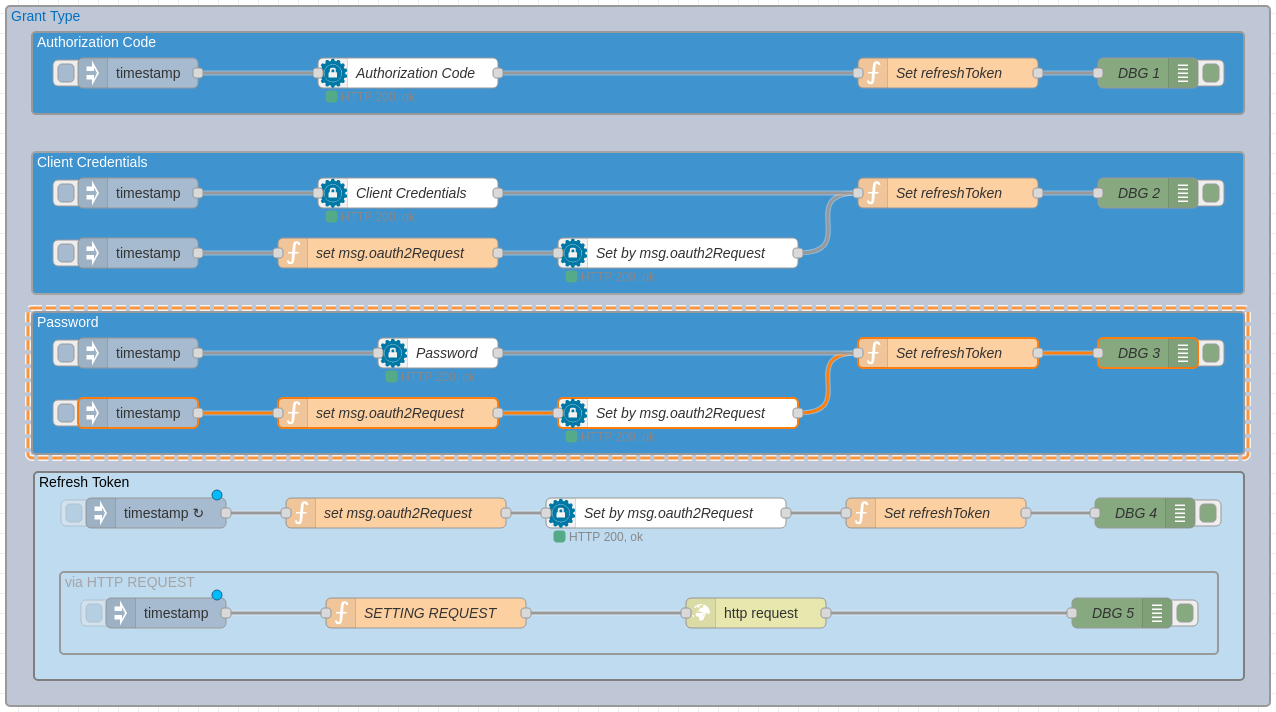node-red-contrib-oauth2
https://github.com/caputomarcos/node-red-contrib-oauth2
node-red-contrib-oauth2 — це вузол Node-RED, який забезпечує потік автентифікації OAuth2. Цей вузол використовує протокол OAuth2 для отримання маркера доступу, який можна використовувати для виконання автентифікованих запитів API.
sequenceDiagram
participant User
participant OAuth2Node
participant OAuth2Server
User->>OAuth2Node: Sends input request
OAuth2Node->>OAuth2Node: Generate request options
alt Credentials set by input request
OAuth2Node->>OAuth2Server: POST request with input credentials
else Credentials set by configuration
OAuth2Node->>OAuth2Server: POST request with configured credentials
end
OAuth2Server-->>OAuth2Node: Returns token
OAuth2Node->>OAuth2Node: Add token to output
OAuth2Node->>User: Sends output response
Ви можете встановити цей вузол безпосередньо з редактора Node-RED, перейшовши в меню «Керування палітрою» та ввівши пошуковий запит node-red-contrib-oauth2. Крім того, ви можете встановити його за допомогою npm:
$ cd ~/.node-red
$ npm install node-red-contrib-oauth2
Вузол вимагає URL-адресу маркера доступу та набір облікових даних клієнта для автентифікації за допомогою цієї URL-адреси. Вузол згенерує HTTP-запит до URL-адреси маркера доступу, щоб отримати маркер доступу за допомогою облікових даних клієнта. Маркер доступу може зберігатися у властивості повідомлення, яке можуть використовувати наступні вузли в потоці.
Вузол забезпечує два режими роботи:
- Статичні облікові дані: облікові дані клієнта можна встановити на сторінці конфігурації вузла.
- Динамічні облікові дані: облікові дані клієнта можна надіслати вузлу як частину корисного навантаження повідомлення.
Приклад
Екпсорт потоку доуступний за посиланням https://github.com/caputomarcos/node-red-contrib-oauth2
У цьому прикладі використано go-oauth2-server , реалізований за допомогою GO (Golang). від RichardKnop
Входи
| Input | Type | Description |
|---|---|---|
| container | string | This refers to the name of the container that is intended to receive the message object. By default, it is set to oauth2Response. |
| grant type | object | This specifies the grant type used to obtain the access token. |
| access token url | string | This is the URL used to obtain the access token. |
| client id | string | This is the unique identifier for the client application. |
| client secret | string | This is the secret key used to authenticate the client application. |
| username | string | This is the username used for authentication. Grant Type: password |
| password | string | This is the password used for authentication. Grant Type: password |
| authorization endpoint | string | This is the URL of the authorization endpoint. Grant Type: authorization code |
| code (read only) | string | This is the authorization code. Grant Type: authorization code |
| scope | string | This specifies the scope of the access request. |
| use proxy | boolean | This specifies whether to use a proxy or not. |
| Proxy Configuration | object | This specifies the configuration for the proxy. User Proxy: true |
| only send non-2xx responses to catch node | boolean | This specifies whether to only catch non-2xx responses. |
| embedded credentials | boolean | This specifies whether to include the client credentials in the token request body for authentication purposes. |
| reject Unauthorized | boolean | This specifies whether to reject unauthorized requests. The rejectUnauthorized parameter controls SSL/TLS certificate validation for the server, with true enforcing validation and false disabling it. |
Note:
- If running behind a proxy, the standard
http_proxy=...environment variable should be set andNode-RED restarted, or use Proxy Configuration. If Proxy Configuration was set, the configuration take precedence over environment variable.
- The OAuth redirect URL is set by default to
/oauth2/redirect, which is the endpoint responsible for receiving the authorizationcode.
Виходи
| Output | Description |
|---|---|
| access_token | This is the access token obtained from the OAuth2 server. |
| expires_in | This is the duration of time, in seconds, until the access token expires. |
| token_type | This is the type of the token. For example, “Bearer”. |
| scope | This specifies the scope of the access granted by the token obtained. |
| refresh_token | This is the refresh token that can be used to obtain a new access token before the current one expires. |
The msg.oauth2Request object contains the OAuth2 request details that are set by the node. The following are the different types of credentials that can be used for authentication:
Client Credentials
The client credentials can be sent as part of the message payload to the node. The msg.oauth2Request.credentials object should contain the following properties:
grant_type(string): This specifies the grant type. For dynamic credentials, the value should be set to “client_credentials”.client_id(string): This is the client ID of the OAuth2 client.client_secret(string): This is the client secret of the OAuth2 client.scope(string): This specifies the scope of the access requested.
Here’s an example:
msg.oauth2Request = {
"access_token_url": "http://localhost:8080/v1/oauth/tokens",
"credentials": {
"grant_type": "client_credentials",
"client_id": "test_client_1",
"client_secret": "test_secret",
"scope": "read_write"
},
};
return msg;
Password
The username and password can be sent as part of the message payload to the node. The msg.oauth2Request.credentials object should contain the following properties:
grant_type(string): This specifies the grant type. For password credentials, the value should be set to “password”.client_id(string): This is the client ID of the OAuth2 client.client_secret(string): This is the client secret of the OAuth2 client.scope(string): This specifies the scope of the access requested.username(string): This is the username of the user.password(string): This is the password of the user.
Here’s an example:
msg.oauth2Request = {
"access_token_url": "http://localhost:8080/v1/oauth/tokens",
"credentials": {
"grant_type": "password",
"client_id": "test_client_1",
"client_secret": "test_secret",
"scope": "read_write",
"username": "test@user",
"password": "test_password"
},
};
return msg;
###
refreshToken
A refresh token can be used to obtain a new access token without requiring the user to re-authenticate. The msg.oauth2Request.credentials object should contain the following properties:
grant_type(string): This specifies the grant type. For refresh token credentials, the value should be set to “refresh_token”.client_id(string): This is the client ID of the OAuth2 client.client_secret(string): This is the client secret of the OAuth2 client.scope(string): This specifies the scope of the access requested.refresh_token(string): This is the refresh token obtained from a previous authentication.
Here’s an example:
let refreshToken = global.get('refreshToken');
msg.oauth2Request = {
"access_token_url": "http://localhost:8080/v1/oauth/tokens",
"credentials": {
"grant_type": "refresh_token",
"client_id": "test_client_1",
"client_secret": "test_secret",
"scope": "read_write",
"refresh_token": refreshToken
},
};
return msg;
